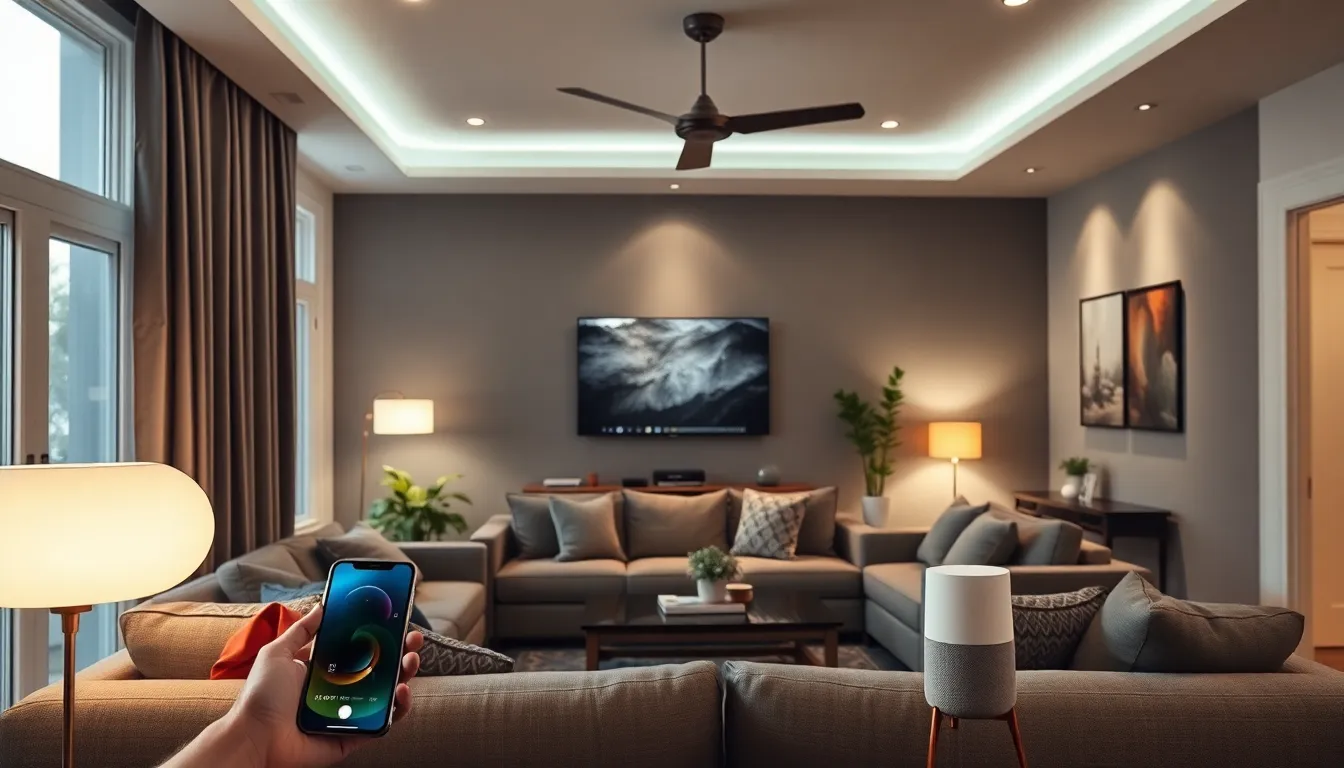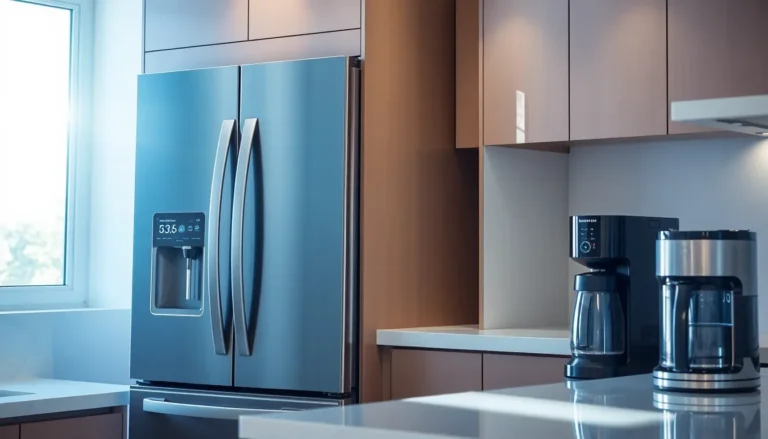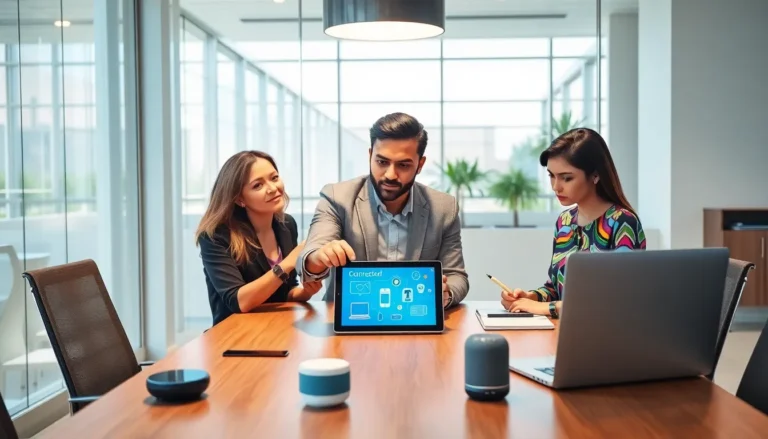Imagine walking into a room and having the lights magically adjust to your mood, all while your smartphone sits comfortably in your pocket. Welcome to the world of IoT lighting systems, where smart technology meets everyday convenience. These systems aren’t just about turning lights on and off; they’re about transforming spaces and enhancing lifestyles.
Table of Contents
ToggleOverview of IoT Lighting Systems
IoT lighting systems provide advanced capabilities for adjusting illumination based on user preferences. These systems utilize smart technology, enabling users to control lighting remotely via smartphones or tablets. Customization ranks high in consumer interest, allowing for personalized lighting settings that enhance ambiance and comfort.
Timely automation features adjust brightness according to natural light levels, ensuring optimal energy efficiency. Users can schedule lighting to activate or deactivate based on routines, significantly reducing energy consumption. Advanced sensors detect occupancy, turning lights on or off to conserve power when rooms are unoccupied.
Integration with smart home ecosystems plays a crucial role in enhancing functionality. For instance, IoT lighting can sync with devices such as smart speakers, security systems, and thermostats. This allows for seamless control and creates a cohesive smart home environment.
Real-time data analysis optimizes performance by adjusting settings based on usage patterns. This analytical approach leads to a more intelligent and efficient lighting experience. Safety improvements also stem from IoT systems, as they can alert homeowners to unusual activity or provide remote monitoring capabilities.
Security lighting options include features such as motion detection and alerts, which keep homes safe while maintaining comfort. Customizable color and brightness options empower users to select various hues for different activities or times of day.
Compatibility with voice assistants such as Amazon Alexa or Google Assistant simplifies user interaction. This ease of use further highlights the user-friendly nature of IoT lighting systems, attracting a broad audience seeking modern convenience.
Benefits of IoT Lighting Systems
IoT lighting systems provide numerous advantages that enhance both living spaces and user experiences. They improve energy efficiency, increase control over lighting settings, and enhance security features.
Energy Efficiency
Energy efficiency stands out as a primary benefit of IoT lighting. These systems automatically adjust brightness based on natural light levels, significantly reducing energy consumption. Sensors detect occupancy and can turn off lights in unoccupied areas, minimizing waste. According to studies, integrating IoT lighting can lower electricity bills by up to 30%. Users can schedule lighting patterns that align with their routines, ensuring lights operate only when necessary. This results in a sustainable approach to energy use that benefits the environment and the household budget.
Increased Control
Increased control is another significant advantage of IoT lighting systems. Users can customize lighting intensity, color, and schedules through smartphone apps or voice commands. Automated features allow for easy adjustments based on individual preferences or activities, such as working, relaxing, or entertaining. Homeowners synchronize lighting with other smart devices, creating seamless experiences throughout the living space. Integration with platforms like Amazon Alexa and Google Assistant adds convenience, letting users command their lighting through simple voice instructions. Such enhanced control caters to diverse lifestyles and promotes personalization.
Enhanced Security
Enhanced security features provide peace of mind for homeowners. IoT lighting systems can include motion detectors that trigger lights when unexpected movement occurs, deterring intruders. The ability to create customized schedules that simulate occupancy makes homes appear active, even when residents are away. In addition, real-time alerts inform users of unusual activity detected by lighting systems. Such features contribute to a robust security architecture, making it easier for homeowners to protect their properties. This integration helps foster a sense of safety that many seek in today’s residential environments.
Types of IoT Lighting Systems
IoT lighting systems come in various types, each offering unique features and benefits. Exploring these categories shows how they enhance efficiency and convenience.
Smart Bulbs
Smart bulbs serve as versatile options for homeowners. Users can easily install them in existing fixtures without needing extensive rewiring. These bulbs connect to Wi-Fi, enabling control through mobile apps or voice commands. For instance, settings allow brightness adjustments and color changes to create personalized atmospheres. Energy efficiency is a key advantage, as smart bulbs can use up to 80% less energy than traditional incandescent bulbs. They also can schedule lighting based on routines, enhancing overall home automation.
Smart Fixtures
Smart fixtures integrate lighting into a comprehensive home design. These products often come with built-in smart technology, providing seamless operation without the need for additional devices. Installation typically requires more effort than smart bulbs, as they may involve hardwiring. Users appreciate built-in sensors that adjust light levels according to ambient conditions. Many fixtures also offer advanced features like motion detection, contributing to increased security. This integration contributes to a modern, stylish aesthetic while optimizing light distribution throughout spaces.
Smart Lighting Controls
Smart lighting controls enhance management of entire lighting systems. They include hubs, switches, and remote controls, allowing users to regulate multiple lights simultaneously. Functions often feature schedules and scenes, which create specific lighting setups for various activities. Users can integrate these controls within smart home ecosystems, achieving synchronization with other devices. Compatibility exists with popular voice assistants, making it easy to issue commands verbally. The convenience promotes energy savings, as users can manage settings remotely to ensure lights are off when not needed.
Implementation Challenges
Implementing IoT lighting systems presents several challenges that can impact functionality and user experience. These include connectivity issues and compatibility with existing systems.
Connectivity Issues
Connectivity problems often hinder optimal functionality of IoT lighting systems. Users may experience interruptions in communication due to weak Wi-Fi signals or network congestion. Signal interference from other wireless devices contributes to these difficulties. Latency in response times can frustrate users, diminishing the seamless experience IoT systems offer. Ensuring reliable connectivity necessitates investment in robust networking equipment. Users should also consider the layout of their homes to facilitate effective signal propagation.
Compatibility with Existing Systems
Compatibility with existing lighting setups poses another challenge. Many homes feature legacy systems that lack the required infrastructure for seamless integration. Transitioning from traditional lighting to IoT systems often requires replacing fixtures or incorporating additional controllers. Users might encounter difficulty when trying to synchronize old devices with newer IoT technology. Selecting IoT solutions that offer backward compatibility can alleviate some of these concerns. Nonetheless, thorough planning and assessment of current systems are essential for a successful transition to IoT lighting solutions.
Future Trends in IoT Lighting
IoT lighting systems will continue evolving, showcasing innovative trends that enhance functionality and user experience.
Integration with Smart Home Technology
Integration with smart home technology increases the versatility of IoT lighting systems. Homeowners benefit from synchronizing their lighting with devices like smart speakers, thermostats, and security cameras. This seamless interaction enables centralized control through a single app. Moreover, remote monitoring becomes easier, allowing users to manage their lighting from anywhere. Enhanced compatibility with emerging smart home devices amplifies usefulness, making IoT lighting a key component of modern homes. Additionally, real-time communication between devices ensures automated responses to changes in the environment, further improving convenience and energy savings.
Advances in AI and Automation
Advances in AI and automation will reshape IoT lighting systems dramatically. AI algorithms can analyze usage patterns to anticipate user preferences, making adjustments based on past behaviors. This personalization creates a more intuitive lighting experience. Users may notice automated changes in brightness that complement their activities, such as dimming lights during movie time. Furthermore, smart sensors can enhance efficiency by responding in real-time to natural light levels, optimizing energy consumption without user intervention. As AI continues to develop, expect remarkable improvements in the capabilities of IoT lighting systems, elevating user comfort and convenience significantly.
Conclusion
IoT lighting systems represent a significant leap in modern home technology. They not only enhance user experience through personalized settings but also contribute to energy efficiency and improved security. As these systems continue to evolve, their integration with smart home ecosystems will offer even greater convenience and control.
The potential for AI-driven automation promises to further refine how users interact with their lighting environments. By embracing IoT lighting solutions, homeowners can enjoy a tailored ambiance that fits their lifestyle while also enjoying the benefits of energy savings and enhanced safety. As technology advances, the future of lighting looks brighter than ever.







